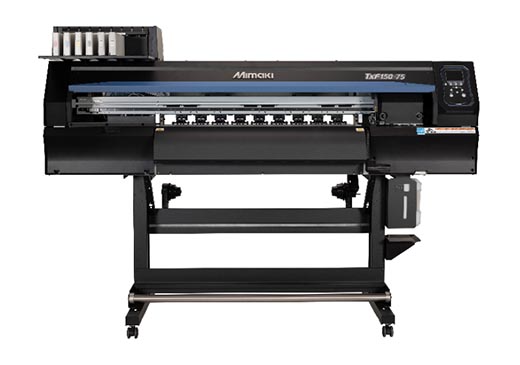Mimaki Announces the Launch of is First DTF Printer, “TxF150-75” and Heat Transfer Pigment Ink for DTF, “PHT50” for Textile and Apparel Printing Applications

Suwanee, GA — Mimaki USA, a leading manufacturer of wide-format inkjet printers and cutters, has developed its first direct-to-film (DTF) printer, “TxF150-75,” and heat transfer pigment ink “PHT50” for DTF. The products are targeted at apparel and textile printing applications. Sales will start in the summer 2023.
DTF printing, which is used often in T-shirt printing, has gained popularity in the apparel and textile industry. DTF printing involves the first printing of the design directly on a special transfer film. Next, the film is coated with hot-melt powder. The film is heated and dried to form an ink layer that can be transferred to the film. To complete the product, the ink layer is transferred onto the fabric using a heat press.
The TxF150-75 is an inkjet printer with a maximum printing width of 80 cm (31.5”) for producing DTF print transfer sheets. The new PHT50 heat transfer pigment ink made for DTF applications consists of five colors (CMYK and white), and is scheduled to obtain the ECO PASSPORT certification by the end of March 2023, which is essential for meeting the international safety standard for textile products “OEKO-TEX.”
To overcome the ink ejection defects and white ink clogging that have plagued previous DTF printers, Mimaki has adopted a degassing ink design which employs aluminum packs to encase the ink, along with a white ink circulation function MCT (Mimaki Circulation Technology)*1. This new printer also features Mimaki’s NCU (Nozzle Check Unit)*2 and NRS (Nozzle Recovery System)*3 technologies to support stable operation. These features allow for continuous printing and higher production.
Silk screen printing is currently a very popular option in the wearables market. This labor-intensive process involves the preparation of plates and is not suitable for small-lot production. Full-color printing takes time and labor to make plates for each colour. An alternative heat transfer method using vinyl sheets is also commonly used, but it involves manual labor for “weeding,” which is the process of manually removing unnecessary portions of the transfer before fixing the printed design on the fabric. Direct-to-garment (DTG), which uses inkjet printers, allows for the printing of designs directly onto fabrics and garments. DTG printing doesn’t require plates, and can be used to print full-color. However, it does require fabric pretreatment and manual handling by each operator at each step.
DTF printing eliminates the need of plate preparation and weeding that are often difficult with conventional printing methods. DTF printing, which allows an unattended process operation for printing, is rapidly becoming a preferred technology to reduce labor time and costs.
The TxF15075-75 will be available for purchase in the summer of 2023. It will include inks, printers, and RIP software.
Customers will receive our recommended specifications for the transfer sheet, hot melt powder, powder application equipment and heat press transfer machine at the time they are sold.